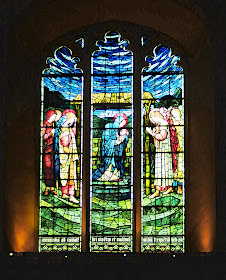When you stroll along Jesus Lane in Cambridge, if indeed you do pass that way as it doesn't look that promising, the College is scarcely visible. You may see the entrance to the Master's Lodge with a prominent sign telling you that it's Private and you may spot an iron gate, left ajar, but leading to a narrow lane lined with bicycles. There's nothing to say Hey, come on in and look around but nothing to tell you that you can't either.
So in you go, past the bikes, through the gatehouse and into Jesus College. Once inside you'll find everything very spacious, calm and ordered; you may find yourself wanting to go up to the students ambling through this paradise and tell them that the rest of the world is not like this at all.
But lets suppose that you keep this urge under firm control and you content yourself with exploring the buildings. You'll find buildings of all ages surrounding the neatly trimmed lawns; buildings from the 1960s right back to the twelfth century. This is a bit of a surprise as the College was not founded till 1496 under the name of The College of the Blessed Virgin Mary, Saint John the Evangelist and the glorious Virgin Saint Radegund, near Cambridge. The Saint Radegund bit coming from the fact that the College appropriated the buildings of the old St Radegund Nunnery which dated back to 1157.
The name Jesus College, which is used nowadays, comes from Jesus Chapel which the college inherited from the Nunnery. The history of the building is complex and any account of its architectural development includes lots of probably's and maybe's. I don't intend to bore you with them here, lets just step inside and see what there is to see.
The Chancel is the showpiece of the building, rather dim and atmospheric with lots of rich dark wood and stained glass - a nightmare for taking photographs in fact!
The glass in the tall, narrow lancet windows in the east end of the chapel is full of deep colours, just right for windows of this age. But not, I'm afraid, the original glass. That was all smashed by Protestant iconoclast William Dowsing, who held it all to be far too idolatrous for his strict interpretation of the Bible. The glass we see today was designed by Augustus Pugin, based on a few fragments which survived Dowsing's vandalism.
There are two organs standing right next to each other, the one on the right having amazing painted panels - again the work of Pugin.
The dark, almost black, carved wood has some interesting features too, some of it Medieval and some later imitations.
Up above in the crossing tower and the nave there is more painted woodwork from the Victorian era, dating from Bodley's restoration. It was designed by William Morris and painted by Frederick Leach.
The coffin lid (above) dates from the thirteenth century and is probably that of Bertha, a benefactress of the nuns who were here at that time.
But perhaps the most famous and striking work on show in the Chapel is a set of stained glass windows by Sir Edward Burne-Jones which were commissioned in 1912. More of Burne-Jones's work can be seen in the windows of the nave. It's one of the finest collections of Burne-Jones stained glass in the country, even though it veered away from the scholarly reconstructions undertaken by Pugin. Shortly after the glass was installed it was announced that William Morris & Partners, with whom Burne-Jones was associated, would cease to make stained glass for churches.
Outside again I was taken by these strange and alien shapes, some of the wackiest topiary you're ever likely to find....
Take care.












It was very nice you took me with you walking here inside this very old building.
ReplyDeleteEverything is beautiful.
Hugs
What a magnificent find, John. I was hooked from the worn stones at the gate to the dark, crowded chancel and the twin organs. Stunning!
ReplyDeleteOh la! Wonderful details here John, especially the magnificent stained glass windows. How could you leave us wondering about the extraordinary topiary shapes, there has to be some sort of celestial story here :)
ReplyDeleteOh, my. I do enjoy your photography and information! I would love to see some of it for myself. I could not even tell you what I liked best...it is all wonderful
ReplyDeleteGreat post. You had me hooked by the thought of you wandering up to students to tell them that the world is not like that at all. Do you think they notice all the treasure there in that world of theirs?
ReplyDeleteOh what an interesting place! Love all the history.
ReplyDeleteI get the feeling of tidiness and enclosure when I look at your interior shots. Very religious in atmosphere Nice -- barbara
ReplyDeleteBeautiful place! That big stained glass window is incredible, as stained glass windows go.
ReplyDeleteI would love visiting this area, great photos John. I especially loved that second shot.
ReplyDeleteYou find interesting history everwhere, but then you have quite a lot in that neighbourhood. kudos for the presentation.
ReplyDeleteI've spent more time looking round the Oxford colleges than the Cambridge ones but this is a gem. The Burns-Jones window is lovely and it all looks so peaceful.
ReplyDeleteSome of these old churches are like old family homes with various pieces of furniture and paintings added over the years. Even today some people have urns with ashes of dead relatives in their homes which is sort of like the tombs in the church floors.
ReplyDeleteVisiting with you is probably even better than visiting in person. All of this history and beauty hidden behind an unprepossessing gate . . . glad you wandered in.
ReplyDelete